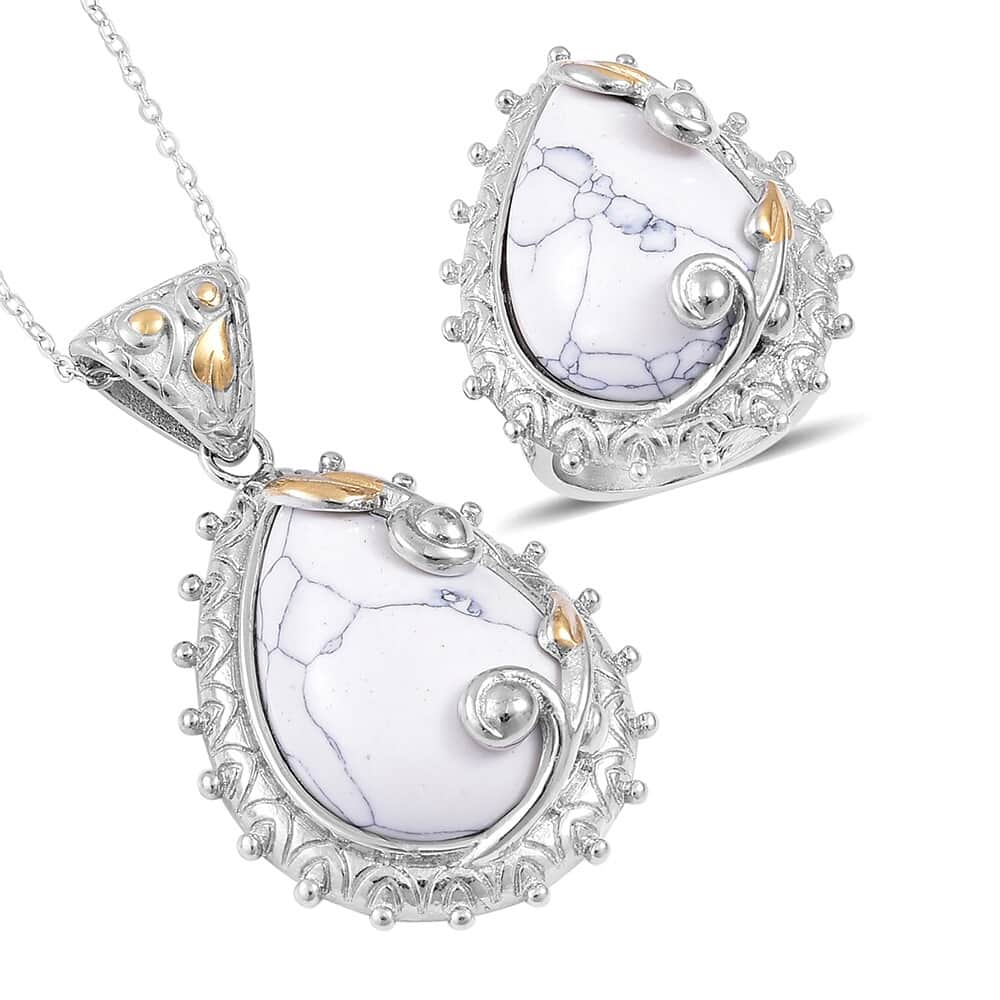WHAT IS HOWLITE GEMSTONE?
Like polished marble, the earthy appeal of natural howlite draws us in with a soothing presence. You find a white rock with dark veins running through it. Shaped like a head of cauliflower, it feels solid with a chalky texture. In your hand, you’re holding a genuine howlite stone. Often used to imitate turquoise, learn how to identify howlite and how to tell howlite apart from turquoise and other gemstones.

While howlite can exist in a crystal form, this is extremely rare. Crystal howlite has only been found in a few locations, and these specimens are tiny, measuring less than one centimeter. Howlite used for carving, or in gemstone jewelry, forms in nodules with a distinct cauliflower appearance.
The hardness of howlite ranges between 3.5 to 6.5 on the Mohs scale. The soft nodule form has the lowest portion of the Mohs hardness. It breaks apart into grains that are later used for shaping or carving. Crystal specimens possess the harder ranking.
Howlite Treatment
Some might ask, “Is howlite real?” What is really being asked is whether the stone is treated. Howlite exists as natural stone, free of treatment. But many stones also undergo enhancement.
Highly porous, howlite takes dye exceptionally well. Combined with its appealing spider web matrix, dyeing howlite to imitate turquoise is extremely popular. Besides a turquoise color, you can find howlite dyed in practically any color available. Shop LC offers howlite in white, blue, purple, pink, green, red, orange, and many more colors!
Besides dyeing, in rare instances, howlite may be impregnated with a colorless resin. This stabilizes the material, making it easier to shape.
Who Can Wear Howlite?
With its compelling variety of dyed stones, howlite is a gem anyone can wear. Natural white howlite is popular in Southwestern influenced jewelry, such as the Santa Fe Style Collection. When used to imitate turquoise, you’ll find howlite set in a variety of metals, with sterling silver and stainless steel among the most popular options.
In its original color, white howlite is natural and neutral. It’s an excellent option for anyone who wants jewelry with a more subdued approach. Dyed options take this further, opening the doors of possibility.
With a stone that’s so versatile, it’s merely a matter of choosing a color you love!
How Does Howlite Compare to Other Stones?
White, opaque stones tend to be unusual and infrequently seen. With its pleasing luster and ceramic color, the closest comparison to howlite is white opal. White opal stands apart with its play-of-color and glossy finish.
What is White Buffalo Turquoise?

Where Does Howlite Come From?
Howlite occurs in many locations throughout the world and is frequently found in deposits of borate. Countries like Canada, Germany, Mexico, Serbia, Slovakia, Turkey, and the United States all host sizeable deposits of this material.
Who Discovered Howlite?
The discovery of howlite easily traces back to its namesake, the Canadian mineralogist Henry How. It was discovered in the province of Nova Scotia, near the city of Windsor, in 1868. After being notified of a nuisance material by miners, further investigation lead How to discover howlite.
Initially, How described his find as silico-boro-calcite, a simple explanation based on the mineral makeup of the material. An American contemporary, James Dwight Dana, would soon rename the find to honor How and his discovery, calling it howlite. Dana is best-known for creating the Manual of Mineralogy, a text that is still continually edited to this day.
How is Howlite Mined?
Occurring within borate deposits howlite is not usually mined on its own. Instead, it’s a byproduct of mining for other material, such as gypsum. Supplies of howlite are abundant, and the stone is very easy to acquire.

Howlite Properties
What Does Howlite Mean?
From a metaphysical perspective, howlite is seen as a calming stone. Gem therapists utilize howlite in their practice to reduce feelings of stress, anxiety, and the other tensions that seep into our daily lives. Once calmed, they feel, howlite opens the door to other means of elevation and elation.
Besides improving mental health, crystal healers also tout the ability of howlite to improve physical functions of the body. Wearing howlite is said to reduce the physical aspects of stress, such as soreness, by releasing the tension within one’s muscles. Some also suggest that howlite aids in the absorption of calcium into the body.
Advocates of the stone insist that treatment of the stone does not diminish its potential.
Disclaimer: Use of any stone or mineral is not a substitute for professional medical care or treatment, and nothing herein constitutes medical advice, diagnosis, or treatment. Information provided should not be used to treat any illness, injury, medical condition, or ailment without prior consultation with a qualified health professional.
Is Howlite a Birthstone?
In the modern birthstone list, howlite does not represent any particular month. Howlite does not have a strong association with the tropical zodiac and does not pair with any specific sign.
Howlite Facts

• Howlite ranks 3.5 on the Mohs scale of hardness.
• Naturally occurring howlite is white with dark veining in a spider web pattern.
• Significant deposits of howlite are in Canada, Mexico, and the United States.
• Howlite frequently is dyed to create additional colors. Rarely, it may be impregnated to make the material easier to shape.
• White howlite may be incorrectly sold as “white buffalo turquoise.” Howlite dyed to resemble turquoise may be incorrectly called “turquenite.”




